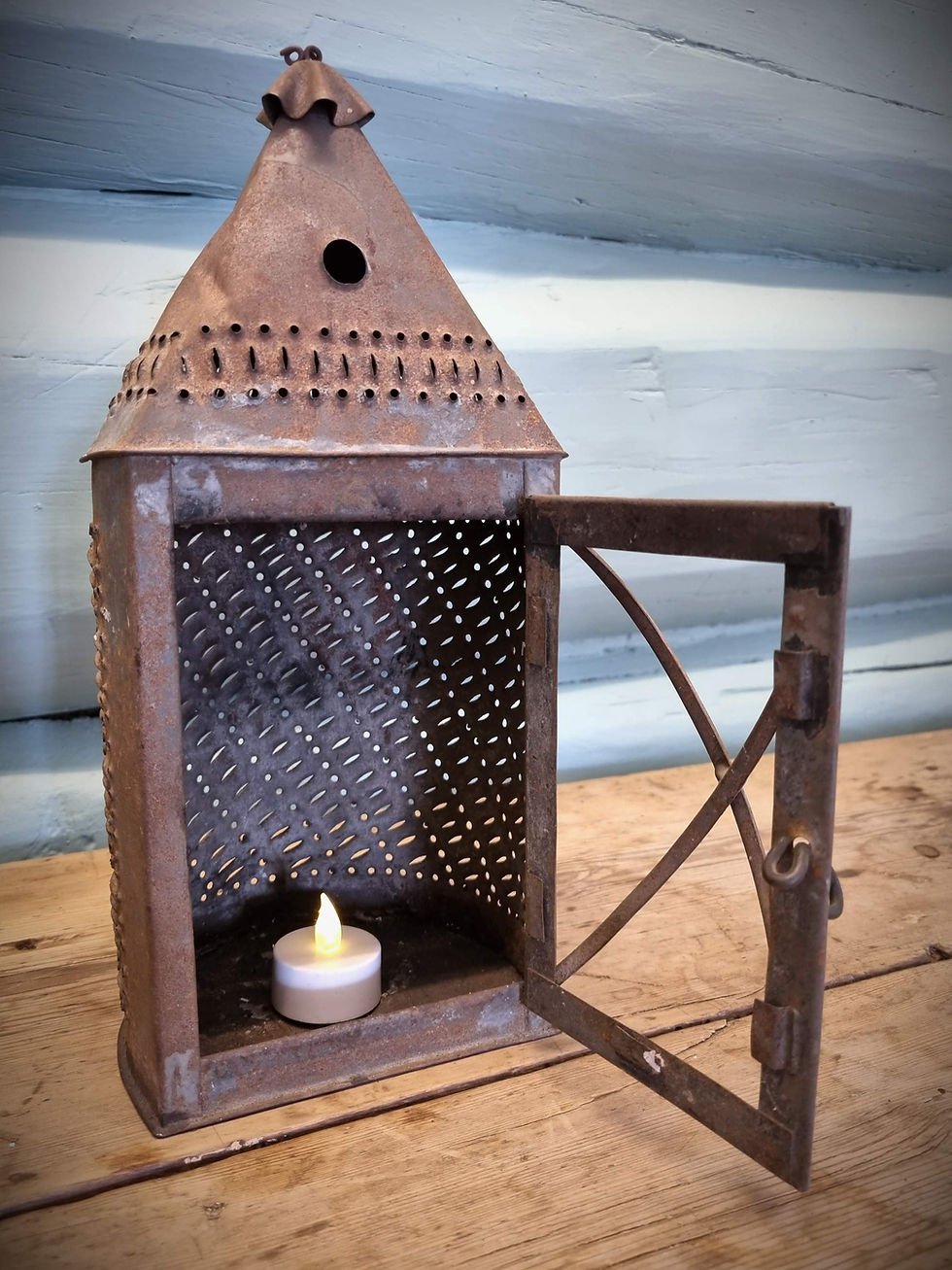Skirt Warmers: How Tin Lanterns Kept Norwegian Women Warm and Saved Lives
- Anne-Ki Magraff

- Mar 27, 2024
- 4 min read
Updated: Nov 4
A charming tradition once flourished among Norwegian women where handcrafted tin lanterns were essential for survival during long, cold winter nights.
These lanterns, referred to as "skirt warmers", symbolized light, warmth, and life.

A Quick Historical Overview of Lanterns and Their Use
Lanterns have illuminated the world for countless generations, serving a multitude of purposes and roles throughout human history.
They have brightened the interiors of humble dwellings and majestic castles, as well as the pathways of dark and spooky alleys, busy unlit streets, churches, shops, horse carriages, and much more. They also played an important role in navigation, communication, signaling, and storytelling.

Lanterns are available in a variety of shapes and sizes. Their design and materials reflect the creativity and culture of their creators. Some lanterns are utilitarian and straightforward, whereas others are complex and ornamental.
For millennia, lanterns have provided light to humans and played a leading role in almost all celebrations. But most importantly, they have offered heat and protection. Even Santa Claus depends on them!
So what are Skirt Warmers?
Skirt warmers are cone-shaped candle holders usually made of tin with a metal skirt around the base to protect the flame from wind and reflect the light. The skirt is traditionally decorated with punched holes or patterns, allowing candlelight to shine through.
But they were not just decorative; they were a vital source of light that pierced through the darkness of the harsh winter nights, keeping the cold at bay and spirits warm.
The Artistry of Norwegian Skirt Warmers
Each lantern was a unique piece, often reflecting the personal style of its maker or owner. The patterns cut into the tin would cast beautiful shadows, turning each lantern into a moving piece of art.

How Skirt Warmers were Made
Skirt warmers were especially popular in rural areas without electricity. They were often made of tin, a malleable metal that was easy to shape and relatively inexpensive to produce.
The skirt warmers had a handle that could be attached around the waist with a strap or a belt. This way, one could have their hands free to carry things or do other tasks.

The lanterns also had a small chamber where one placed a candle or a small paraffin lamp. The light from the lantern was not very strong, but it was enough to see a few meters ahead in the dark, and it provided warmth when hung under skirts.
Legacy of the Skirt Warmers
In the past, women carried tin lanterns under their skirts to keep themselves warm and dry while avoiding tripping on uneven terrain. These lanterns also provided a sense of safety and security, as women could see where they were going and be visible to others. This was particularly useful for women walking in dark forests or mountain paths.
Norwegian skirt warmers, dating back to the 17th century, were more than just light sources; they were intricately crafted pieces of metalwork. Often adorned with cut-out patterns and glass panes, these lanterns cast a warm, dancing glow on the snow-laden paths. Women would carry these lanterns to church, their light guiding the darkened streets and their warmth comforted in the unheated pews.

Warmth in Worship
During long church sermons, these handcrafted lanterns served a dual purpose. They provided a light source in the dimly lit sanctuaries and a source of heat. Women would place their lanterns beneath their skirts, the heat rising to ward off the chill. This practice earned the lanterns the endearing name “skirt warmers,” which encapsulates their practicality and the coziness they brought to sacred spaces.
A Pathway of Light
Beyond the church walls, skirtwarmers were companions in Norwegian women's daily lives. In an era before electric streetlights, these lanterns were essential for evening chores and social visits. The light from a skirtwarmer was a beacon of safety, guiding women through the dark, icy evenings.
Norwegian Folk Art and its Heritage
Today, tin lanterns are a significant part of Norway's cultural heritage. They represent a time when life was more challenging than it is now.

Skirt warmers also demonstrate how people utilized available materials to create functional and practical objects. They are valuable to Norway's cultural heritage and folk art and should be remembered and appreciated.
These beautiful lanterns can be found in museums, old houses, and private collections. They are not hard to find.
I even have one! I found one for sale online, and being the museum rat I am, I couldn't resist. I don't know how old this one is, but it's been used, and I love the moon and star shapes. And boy, do they get hot, so I understand how they must have been lifesavers during the winter.
Ringerikes Museum

You can see these historic "skirt warmers" live at the Ringerikes Museum in Norway—a former rectory only an hour from Oslo—and while you're there, don't miss the beautiful 12th-century Nordrehov Church next door.










_edited.png)



